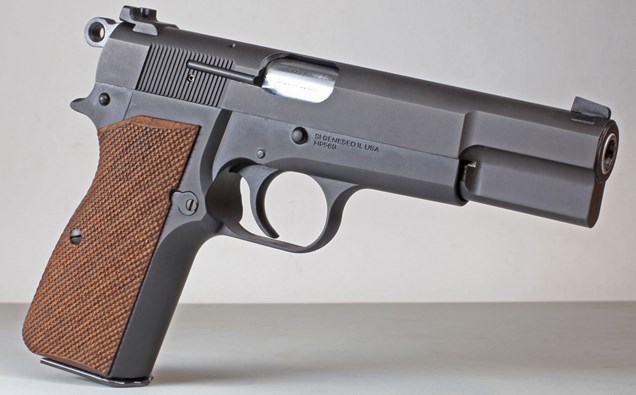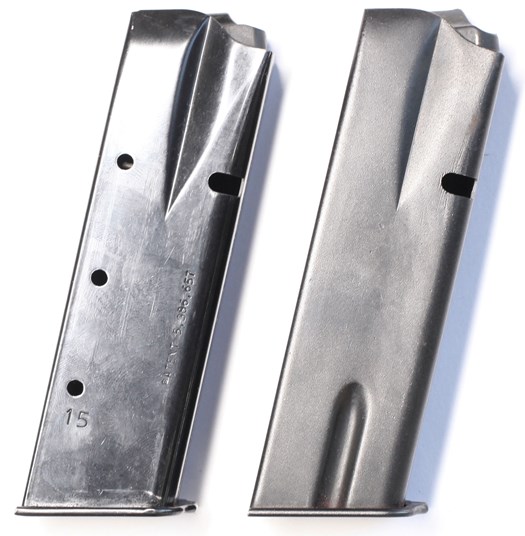
It is a model that appears over and over again in Top 10 lists, some describing the steel-framed 9 mm as “one of the world’s truly great handguns.” In another, American Rifleman Editor-in-Chief Brian Sheetz writes, “The Hi Power is one of the most comfortable and naturally pointable handguns of all time and likely the greatest nine ever.” In 2017, when Browning announced that the model was being discontinued after 82 years of continual production, it seemed like the Hi Power would remain an object of obscure desire for most of us. But all of that changed this week when Springfield Armory announced it is rolling out its own iteration of the iconic design.
Springfield calls its new handgun the “SA-35,” which denotes 1935, the year the first Hi Powers were introduced. The P-35 was the final project of the legendary American gun designer John Moses Browning, who was designing the pistol for the Belgian company Fabrique Nationale (FN). When Browning died in 1926, the work was completed by equally famous FN designer Dieudonné Saive. The P-35 introduced two design features that are used by nearly every modern semi-automatic center-fire handgun. The first is a cam built into the barrel to unlock it from the slide after the pistol fires. The second is a double-column magazine that allows for greater magazine capacity.

Springfield’s SA-35 (left) next to an original Browning Hi Power from the 1960s.
The new pistol was given the title “High Power” because its 9 mm chambering was more powerful than many military pistols of its day, and the 13 rounds it carried nearly doubled the capacity of other contemporary military handguns.
The Hi Power (the American designation for the model) would be used by both sides during World War II. It was kept in production after the FN factory was overrun by the Nazis and the design was sneaked out from occupied Europe and produced in Canada throughout the war for Allied forces. When the war ended, the formation of NATO left many countries looking to adopt a more modern handgun for their armed forces. The Hi Power fit the bill. It would be adopted by nearly 100 countries and law enforcement agencies, including almost every NATO member. There were a few exceptions. One was the United States, which stuck with Browning’s other famous pistol design, the 1911.

The SA-35 in the foreground with an original FN Hi Power (right) and an original WWII-era 1911A1.
For its first four decades, the Hi Power’s double-column magazine was its claim to fame, a feature that wasn’t matched by other designs until the “Wonder Nines” of the 1970s. It was the go-to high-capacity handgun for many of the world’s elite forces, from the British SAS to the FBI’s Hostage Rescue Team.
In the U.S., the Hi Power has always had a small but dedicated following. Though it always played second fiddle to the 1911, it was still popular in competition and self-defense circles, and most well-known 1911 pistolsmiths also customize Hi Powers. As an imported firearm, it was always more pricey than its domestic competitors. With FN’s discontinuation of the model, collectors are looking to shell out upwards of $1,500 for an original Hi Power.
The first time I encountered a Hi Power was when another woman handed one to me at the range. It was her carry pistol. Up until that point I had mainly shot Glocks and 1911s and this new gun seemed a pleasant blend of the two. Several times over the years that followed, I would have the chance to fire a Hi Power. The experience always reminded me of what I liked about the pistol at that first encounter. It wasn’t until Springfield introduced the SA-35, however, that I would have a chance to spend quality time with the design.
At first glance, you can see the homage that Springfield has paid to the original design. The external lines of the SA-35 follow the classic Hi Power nearly exactly. The frame and slide assemblies of the all-steel pistols are made from forgings. The pistol comes in a matte blued finish that harkens back to its military roots.

Springfield has sought to correct three common complaints of Hi Power shooters. The first is “hammer bite” or the tendency of the pistol to pinch the web of the shooter’s hand between the hammer spur and the beavertail of the grip frame. Springfield’s design works, as throughout an extended shooting session with several testers, no one had this problem no matter how they gripped the handgun.
The second issue is a difficult-to-manipulate safety. As the Hi Power is a single-action design that will be carried with the hammer cocked and safety on like a 1911 (“cocked and locked”), it’s important that the safety can be easily, yet positively, engaged and disengaged. The SA-35 uses an extended safety, which clicks positively between its on and off positions. It, and all other controls, including the slide release and magazine release, are left-side only for right-handed shooters.

The final complaint of traditional Hi Power users is trigger pull. While a single-action design, most Hi Powers just didn’t have the trigger pull characteristics of a 1911. Part of the reason was that the original design included a magazine safety that blocks the trigger when the magazine is removed, which was a safety feature that many militaries wanted. The trigger pull weight of the SA-35 averages just under 5 lbs. There is a slight take-up then a pause before it breaks crisply. The trigger has to be let out almost all of the way before it hits the reset.
Another new feature that Springfield adds to the Hi Power design is a flared magazine well that allows for easier magazine insertion. Pressing the magazine release button ejects the magazine forcefully. Unlike the original Hi Powers, the SA-35 will fire without a magazine inserted. Springfield has added two more rounds to the SA-35’s magazine capacity by modifying its follower. The external shape of the magazine stays the same and magazines are interchangeable between the original Hi Power and the SA-35.

SA-35’s magazine (left) and an original FN Hi Power magazine. The magazines are interchangeable between both models.
The SA-35 weighs 31.8 ozs. empty. When loaded, its weight (39 ozs.) falls right between a Glock 19 (30.2 ozs.) and a full-sized, all-steel 1911 (44.4 ozs.).
The thing that many shooters notice about the Hi Power is its grip. Despite its capacity, the Hi Power has about the same grip circumference of a 1911 and is about half an inch less than most polymer-framed handguns that use double column magazines, like the Glock 19. The Hi Power’s boxy grip profile fits the hand quite naturally and allows for relatively small hands to reach the magazine release without having to shift your grip significantly. The checkered walnut grip panels make for a very comfortable feel for your hand. For those wanting to change the grip, most aftermarket Hi Power grip panels will still work on the SA-35.

On the range, we tested the accuracy of the SA-35 both from the bench and standing shooting positions. The front sight is a post with a white dot and the rear is a serrated U-notch blade, which is drift adjustable for windage. The pistol shot to the point-of-aim right out of the box. From a standing position at 7 yards, five-shot groups stayed around an inch-and-a-half. Though the SA-35’s sights are designed for close and quick defensive work, moving back to 25 yards and shooting from a rest, groups stayed between 2” and 3”. We tested cartridges with a variety of bullet types and grain weights, from target FMJs to +P self-defense loads, and reliability was perfect with everything we tried.

A combination of the steel frame and grip design makes recoil of the 9 mm cartridge mild. The backstrap is wide and flat, like a recoil pad on a good shotgun, which helps to distribute forces of the recoil across the palm. After two hours on the range shooting the SA-35, I didn’t feel the lingering sting you get with some handguns. The light, single-action trigger doesn’t pinch or fatigue the finger, even after extended shooting sessions.

Disassembling the SA-35 for cleaning is simpler and easier than a 1911 design. No tools are required. You rack the slide and lock the safety lever in the take down notch and the rest is a breeze. No small parts to fumble with, springs to hold under pressure or bushings to remove, as is the case with 1911-style guns.

Though some wouldn’t consider a two-pound, full-sized pistol to be a carry gun, the SA-35 can be toted around without drama. Its overall length is about an inch and a half shorter than a full-sized 1911 and about half an inch longer than a Glock 19. Using a DeSantis Slim-Tuk IWB holster, I found that the SA-35 carries nicely. The slimness of the SA-35 slide is what helps it tuck inside-the-waist band so easily. Its slide is just slightly narrower than a 1911 and a full quarter inch thinner than the Glock 19. Whether seated or on foot, when stowed in a good inside-the-waistband holster on a sturdy belt, the SA-35 will stay put and is comfortable to carry. With an adequate cover garment a belt-mounted Hi Power blends in with my daily activities.

A DeSantis Slim-Tuk IWB holster sized for Springfield's new SA-35.
If you haven’t had the chance to give the Hi Power design a try, Springfield’s SA-35 offers an affordable and quality chance.
The Springfield Armory SA-35 comes in a soft case, with a gun lock, empty chamber flag and owner’s manual. MSRP is $699.

















































